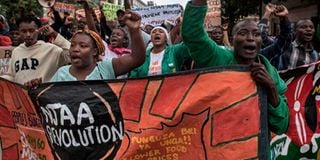Poll uncertainty, inflation and the conundrum of maize flour subsidy

Activists calling themselves 'Njaa Revolution' under the Social Justice Centres Working Group demonstrate the high rise of prices of food commodities and urgent government redress in Nairobi on May 17, 2022.
What you need to know:
- Governments become exceedingly sensitive and even scared of an agitated and angry public especially when they are hungry.
- The current government directive has further dangers. You are fixing the low selling price for a limited period only.
Kenya has been and still is being severely tested by a myriad of challenges and obstacles.
We entered the year with yet another below-average rainfall period, escalating drought and with it growing food and water deficiencies and of course disruptions caused by Covid-19. That brought with it increased inflation.
Remember Kenya still has a large dependency on rain-fed agriculture.
To add fuel to the fire, inflation is now a global issue, as many countries grapple with supply chain issues as a result of post-Covid-19 economic pick-up and of course gaps and disruptions in food supply caused by Russia’s invasion of Ukraine.
Lurking like a great dark shadow over us is the looming election.
This is not necessarily a Kenyan phenomenon.
Destabilising uncertainties
Whilst elections are a vital part of the democratic process, the uncertainties before, during and after the polls can be destabilising.
For Kenya, the danger is stagflation. Economic growth is inhibited by several of the above factors combined, especially rising prices.
This brings me closer to the main point I wish to make. The combination of the above can often lead to politically expedient decisions which are at odds with the greater economic wellbeing.
We are staring at an inflation rate of around 8 per cent. And it is not just food.
The prices of fuel and other economic inputs such as fertiliser have also surged.
Angry public
Governments become exceedingly sensitive and even scared of an agitated and angry public especially when they are hungry.
William Cobbett’s famous phrase that it is hard to agitate a man on a full stomach comes to mind. Conversely, this means it is easy to do that when a man is hungry.
Look at Sri Lanka, where the former President fled and where we can safely say the country is still in the eye of a huge storm.
Whilst one cannot directly compare Kenya to Sri Lanka, there are some similarities such as the huge disparities in wealth and the massive food and fuel inflationary spiral.
Back to Kenya and the final election run-up. The government has resorted to several subsidies with very mixed success.
It is subsidising the price of fuel, a move that has, in turn, depleted its Fuel Development Levy fund and caused long queues at the various pump stations.
Whilst some of the price rises have been passed onto the consumer, a reduced subsidy is still in place.
The pump price remained unchanged on July 14 because the government absorbed the potential increase.
Likely to backfire
It has done the same with fertiliser with mixed results.
Subsidised fertiliser was made available through the National Cereals and Produce Board but it was nowhere near what was needed.
As a result, farmers resorted to paying the market price if they could afford it or significantly less fertiliser was applied, which will in turn negatively affect crop yields.
And now we have the maize flour subsidy conundrum, which is likely to backfire.
Let me re-state the dilemma. The government is between the proverbial rock and a hard place.
If it appears to do nothing, it faces extreme criticism, and if it tries to do something that is unaffordable, unsustainable and exploitable, then it could backfire. And my fear is that backfire it will. Let me tell you why.
World food prices are at an all-time high and are unlikely to come down in the near future.
To try to defy that by artificially fixing the retail price below the cost and distribution price is like trying to stand up to a giant sea wave.
The current government directive has further dangers. You are fixing the low selling price for a limited period only.
The danger is that people will buy and hoard or at best keep more than they need.
This creates an artificial shortage in the market, where the shelves go empty of this cheap maize. This is starting to happen.
I was at a supermarket where consumers were strictly limited to two 2kg packets of subsidised maize flour.
I was at another where the shelves were empty except for some lonely-looking 5kg packets at the unsubsidised price.
When the subsidy runs out, or suppliers stop their supplies for cash-flow reasons as happened at the height of the fuel subsidy, or at worst the country runs short of maize supplies because of import lag times, then shortages occur.
When that happens, the real price in the market kicks in and one will only be able to obtain maize flour at the unsubsidised price whether on the street or behind the street.
Of course, those with deep pockets who buy at the subsidised price will make a killing.
The people who will bear the brunt of this will be the poor. I do not want to predict a calamity.
I just want to forewarn you that the current path is fraught with danger. I very much hope I am wrong.
The writer is an economic and public policy analyst; [email protected]





